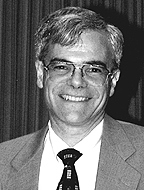
| T H E N I H C A T A L Y S T | J U L Y – A U G U S T 1999 |
|
|
|
| F R O M | T H E | D E P U T Y | D I R E C T O R | F O R | I N T R A M U R A L | R E S E A R C H |
DECISION MAKING IN THE INTRAMURAL RESEARCH PROGRAM
 |
| Michael Gottesman |
The recent town meeting on graduate education at NIH illustrates one means by which the Office of Intramural Research and the NIH director obtain advice and commentary from NIH scientists on new or suggested policies that affect the intramural program. In addition to internal needs, outside forces often compel the development or modification of our policies. These external influences include the Congress, the Department of Justice and the courts, the Department of Health and Human Services, other government agencies that oversee various aspects of our research, and outside review groups.
The goal of the Office of Intramural Research is to integrate these various inputs into a coherent set of policies and procedures that enable intramural scientists to carry out biomedical research and training of the highest possible quality.
Several overriding themes were defined by the External Advisory Committee on the Intramural Research Program (the Marks-Cassell Committee) that have guided decision making in the five years since the report was issued. These include consistent application of rigorous scientific review and recruitment procedures to ensure that intramural resources are well utilized; improvement of the quality of research space on the NIH campus; increased diversity among NIH scientific staff; elimination, insofar as possible, of bureaucratic barriers to the conduct of science; and enhancement of training and mentoring at all levels in the intramural programs. Although you may not agree with every change that has taken place, I hope you recognize that most of the changes manifest these principles.
Another broad theme for intramural policy over the past few years has been improvement of the environment for clinical research at NIH. The NIH Director’s Clinical Research Panel focused attention on the nationwide need for better training and career development for clinical researchers, as well as for increased support for translational and clinical research activities.
Subsequently, rejuvenation of clinical research here at NIH has been guided by a report on recruitment and retention of clinical researchers and by the activities of the Clinical Research Revitalization Committee, chaired by Steve Straus; the Clinical Center Advisory Council, chaired by Steve Hyman and Ed Liu; and the Medical Executive Committee, chaired by Scott Whitcup. Like most of our other initiatives, this effort is a work in progress, but we hope that by the time the Clinical Research Center is completed in late 2002, the clinical research infrastructure at NIH will be in place to optimize the use of the new building.
Recently, we codified and compiled most of the policies and procedures developed over the past several years in support of the activities of our intramural research programs. This information is updated regularly and is readily available to all intramural staff as the NIH Intramural Research Sourcebook.
We expect to see continued evolution in management areas defined by a congressionally mandated administrative review by Arthur Andersen, Inc. Its report pointed to a need to improve communication between the scientific and administrative decisionmakers at NIH. Consequently, we have recruited Janis Mullaney to the Office of Intramural Research to act as a vector for such communication. Ms. Mullaney has extensive intramural experience as an administrative officer (AO), including several years as chair of the committee of lead AOs, and a reputation as a creative administrator dedicated to improving the NIH research environment.
Individual intramural policies supporting our basic principles and themes are made within the institutes or by the Board of Scientific Directors. As a new idea surfaces, it is discussed extensively by the scientific directors, and often by the lab and branch chiefs, who solicit comments within their own scientific domains. As appropriate, the NIH Fellows Committee, Women Scientist Advisors, the Central Tenure Committee, and Senior Biomedical Research Service Policy Board, as well as the special interest groups, may be involved in this process.
On a daily basis, the most important research decisions at NIH are made in our labs and clinics. NIH research is steered by the individual scientific decisions of our principal investigators and the programmatic decisions of institute directors and scientific directors, many of whom conduct their own research in the intramural program. NIH is fortunate to have staff and leadership with the experience, knowledge, creativity, and solid scientific judgment to make sound decisions.
Local decision making may feed back to our office, and ideas that have the capacity to transform the NIH are discussed more broadly—within the pages of The NIH Catalyst (see "Catalytic Reactions,"), the DDIR’s Web Board, and at town meetings within individual institutes or NIH as a whole, for example. Eventually, NIH leaders make their decisions based on all of the inputs described above.
In the case of our collective discussion of graduate studies at NIH, these inputs led to a substantial change in direction from what was initially envisioned. We heard from NIH trainees and staff at every level, in every institute; from experts inside and outside the IRP; from proponents and opponents of a graduate program. We decided that rather than seek degree-granting authority for NIH, we will focus on improving all aspects of our present graduate and postgraduate programs and on improving and forging relationships with partner universities.
This change in course
resets the decision-making cycle and leads me to end this column in my usual
way: by calling on you once again to send me your ideas. ![]()